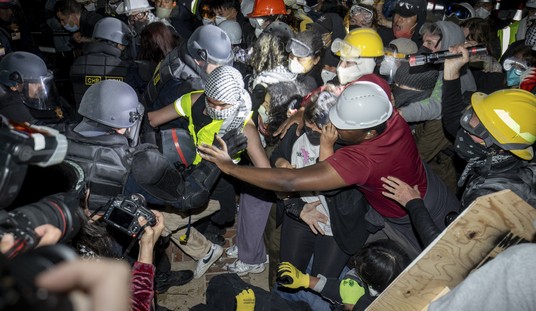“Irene’s got a middle name, and it’s Global Warming…
“Remember—this year has already seen more billion-dollar weather-related disasters than any year in U.S. history. Last year was the warmest ever recorded on planet Earth. Arctic sea ice is near all-time record lows. Record floods from Pakistan to Queensland to the Mississippi basin; record drought from the steppes of Russia to the plains of Texas. Just about the only trauma we haven’t had are hurricanes plowing into the U.S., but that’s just luck—last year was a big storm year, but they all veered out to sea. This year we’re already on letter I—which in a normal year we don’t get to until well into October. Every kind of natural system is amped up, holding more power—about ¾ of a watt extra energy per square meter of the Earth’s surface, thanks to the carbon we’ve poured into the atmosphere. This is what climate change looks like in its early stages.
“But you’d never guess that anything was amiss if you asked the Obama administration.”
“Here’s the right question: is climate change making this storm worse than it would have been otherwise?
“Answer: Absolutely
“For one thing, sea-surface temperatures in the Atlantic Ocean are higher now than they used to be, thanks to global warming, and ocean heat is what gives hurricanes their power. All other things being equal, a warmer ocean means a more powerful storm. It’s hard to say that all other things are exactly equal here, but it’s certainly plausible that Irene would have been a little weaker if precisely the same storm had come through, say, 50 years ago.
“What we know for sure, however is that thanks largely to climate change, sea level is about 13 inches higher in the New York area than it was a century ago. The greatest damage from hurricanes comes not from high winds and torrential rains — although those do cause a lot of damage. It’s from the storm surge, the tsunami-like wall of water a hurricane pushes ahead of it to crash onto the land. It was Hurricane Katrina’s storm surge, not the wind or rain, that destroyed New Orleans back in 2005.”
“Among those who disagree is Thomas R. Knutson, a federal researcher at the government’s Geophysical Fluid Dynamics Laboratory in Princeton, N.J. The rising trend of recent decades occurred over too short a period to be sure it was not a consequence of natural variability, he said, and statistics from earlier years are not reliable enough to draw firm conclusions about any long-term trend in hurricane intensities.
“‘Everyone sort of agrees on this short-term trend, but then the agreement starts to break down when you go back longer-term,’ Mr. Knutson said. He argues, essentially, that Dr. Emanuel’s conclusion is premature, even while conceding that evidence for a human impact on hurricanes could eventually be established…
“One climate-change projection, prepared by Mr. Knutson’s group, is that the annual number of the most intense storms will double over the course of the 21st century. But what proportion of those would actually hit land is another murky issue. Scientists say climate change could alter steering currents or other traits of the atmosphere that influence hurricane behavior.”
“The science behind warming and storms is a lot more complex than McKibben describes, and it’s worth noting that the average number of hurricanes making landfall on the U.S. has remained at around 1.69 since 1851, without much of a trend upwards or downwards. While it’s obviously true that whether or not a storm makes landfall on the U.S. in a given year is a matter of luck, you’d imagine that if climate change led to more frequent storms, the very real warming we’ve seen over the past century would eventually increase the average number of hurricanes hitting the country. That hasn’t happened yet.
“Nor have we seen a clear upward trend in the amount of damage hurricanes have been causing. It’s true that damages from hurricanes has generally increased over the past century, even adjusting for inflation—and you can be sure that Irene will push that trend even higher. But that trend collapses once you normalize for the astounding population and economic growth the U.S.—and especially the East Coast—has experienced over the last 100 years, as this 2008 paper from Pielke Jr. et. al shows. Adjusted for those factors, and even Katrina pales against the great Miami storm of 1926, which would have cost $157 billion in 2005 dollars.
“Does that mean we don’t need to worry the impact that climate change might have on major storms? Absolutely not. We suspect that as the ocean surface temperatures warm—as McKibben points out—there will be more fuel for tropical storms, while warming alone will increase the amount of precipitation in the atmosphere.”
“McKibben’s effort to use this United States hurricane landfall as a specter of things to come in a greenhouse-heated world doesn’t mesh with the science, which shows a measurable, though subtle, trend in the opposite direction. That’s why I agree with Keith Kloor’s conclusion that this kind of rhetoric is ‘undermining the legitimacy’ of the call to reduce emissions of greenhouse gases.
“In 2008, researchers from the National Oceanic and Atmospheric Administration and University of Miami published ‘Global warming and United States landfalling hurricanes,’ a long-view analysis of patterns in hurricanes striking United States shores in relation to climate conditions. Their prime conclusion was that warming seas are associated with rising wind shear — a hurricane-killing condition — in the part of the Atlantic that is a nursery for the kinds of hurricanes that tend to strike the United States. The rise in wind shear appears to be associated with ‘a weak but robust downward trend in U.S. landfalling hurricanes.’ Their work built on earlier analysis drawing the same conclusion.”
“The former vice president also criticized climate change skeptics, urging those who support curbs to greenhouse gases to ‘win the conversation’ when it comes to global warming. [Gore] compared the struggle against climate skeptics to the fight against racism during the civil rights movement.
“When racist comments would come up in the course of conversations, ‘There came a time when people said, ‘Hey man, why do you talk that way? That’s wrong, I don’t go for that, so don’t talk that way around me. I just don’t believe that.'”








Join the conversation as a VIP Member